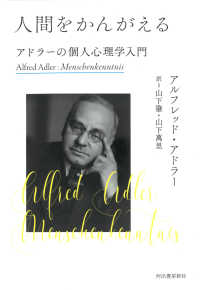- ホーム
- > 洋書
- > ドイツ書
- > Humanities, Arts & Music
- > Arts
- > architecture
Full Description
The edition offers a new approach to what Weizman names "documentary architecture," meaning that to write about the history of a building is also to map the world in which it is located.
After the First World War and under the British Mandate, Haifa grew from a small Ottoman port town into a regional metropolis and industrial center around a deep seaport. The city was part of an open space that extended from Cairo to Damascus through Beirut, in a region where Syria, Palestine, and Lebanon were part of the same fluid, interconnected space. During the Second World War, Haifa became a border town. Under French Vichy, the border between Lebanon and Syria ran sixty kilometers to the north and hardened only after the creation of Israel in 1948 and the wars with Lebanon. Haifa's architectural modernism developed in relation to the city's geopolitical environment. No building better manifests Haifa's predicament than the modernist casino building, built in the city's Bat Galim seafront district.







